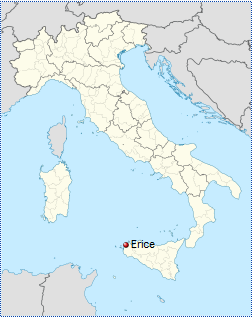Erice - History
 | The ancient Greek name of Erice was Eryx (Έρυξ in Greek), and its foundation was associated with the eponymous Greek hero Eryx. It was not a Greek colony, as the Phoenicians founded it, but was largely Hellenized. It was destroyed in the First Punic War by the Carthaginians, and from then on declined in importance.
|
Eryx was conquered by Aghlebids in 831 and was renamed as Cebel Hamid (In Western sources Gebel Hamed, meaning Mountain of Hamid). It was ruled by Arabs until the Norman conquest. In 1167 the Normans renamed it Monte San Giuliano. It was known as Monte San Giuliano until 1934. In the northeastern portion of the city there are the remains of ancient Elymian and Phoenician walls indicating different stages of settlement and occupation in antiquity. There are two castles that remain in the city: Pepoli Castle, which dates from Saracen times, and the Venus Castle, dating from the Norman period, built on top of the ancient Temple of Venus, where Venus Ericina was worshipped. According to legend, the temple was founded by Aeneas. It was well known throughout the Mediterranean area in the ancient age, and an important cult was celebrated in it. In his book On the Nature of Animals, Aelian writes that animals chosen for sacrifice would voluntarily walk up to the altar to be killed. A cable car (funivia) runs from the outskirts of Trapani to the town of Erice. The cablecar closes from mid January to mid March. | |
